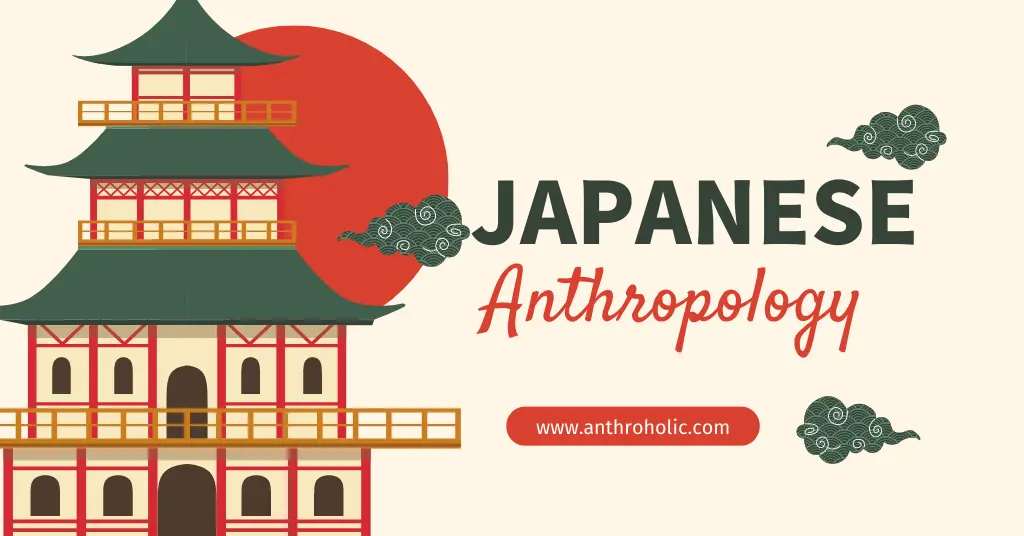AI Answer Evaluation Platform Live Now. Try Free Answer Evaluation Now
Japanese Anthropology
Japanese Anthropology is a rich and diverse field that explores the cultural, social, and historical aspects of Japanese society. The study of Japanese culture and its people is significant because it offers insights into one of the world’s oldest and most enduring civilizations, which has not only preserved its unique identity but also adapted and innovated over the centuries.

Historical Development of Japanese Anthropology
Japanese Anthropology traces its roots back to the late 19th and early 20th centuries when Japan opened its doors to the Western world after centuries of isolation. Early scholars, both Japanese and Western, sought to document and analyze Japanese society, often with a focus on customs, folklore, and language.
| Name | Nationality | Notable Works |
|---|---|---|
| Basil Hall Chamberlain | British | “Things Japanese” (1890) |
| Frederick Starr | American | “Japanese Culture” (1920) |
| Kunio Yanagita | Japanese | “Tono Monogatari” (1910) |
The Emergence of a Discipline
The establishment of academic institutions and research organizations in the early 20th century paved the way for the formal development of Japanese Anthropology. Key figures like Kunio Yanagita and Chikao Fujisawa played a significant role in laying the groundwork for a uniquely Japanese anthropological tradition.
1.3. Post-War Developments
The aftermath of World War II and Japan’s rapid economic growth led to increased interest in Japanese society from both domestic and international perspectives. This period also saw the emergence of new theoretical approaches and methodologies, as well as a diversification of research topics.
Key Concepts and Sub-disciplines
- Nihonjinron: Nihonjinron, or theories of Japanese uniqueness, is a collection of ideas that argue for the distinctiveness of Japanese culture and people. These theories emerged in the post-war era and often emphasize aspects like language, aesthetics, and social structure (Sugimoto, 2010).
- Social Organization: Japanese Anthropology has traditionally focused on the study of social organization, including kinship, marriage, and household structure. Research on these topics has illuminated the complex and diverse ways in which Japanese society is organized, both historically and in contemporary times (Kelly & White, 2006).
- Religion and Folklore: The study of religion and folklore is a crucial aspect of Japanese Anthropology, shedding light on the belief systems, rituals, and myths that have shaped Japanese culture. This sub-discipline includes research on Shinto, Buddhism, and various folk practices and beliefs (Reader & Tanabe, 1998).
- Gender and Sexuality: Gender and sexuality studies have become increasingly prominent in Japanese Anthropology, with researchers examining the changing roles and expectations for men and women in Japanese society. Key topics include gender roles, the family, and sexuality (Roberson & Suzuki, 2003).
Theoretical Approaches and Research Methods
- Structuralism: Structuralism is a theoretical approach that seeks to understand the underlying structures of culture and society. In Japanese Anthropology, structuralism has been influential in the study of social organization, particularly in the analysis of kinship and marriage systems (Lebra, 1976).
- Symbolic Anthropology: Symbolic Anthropology focuses on the meaning and significance of symbols, rituals, and myths in a given culture. In the context of Japanese Anthropology, this approach has been applied to the study of religion, folklore, and various aspects of everyday life (Moeran, 1984).
- Postmodernism: Postmodernism is a theoretical perspective that emphasizes the plurality of perspectives and the subjective nature of knowledge. This approach has gained traction in Japanese Anthropology, particularly in the areas of gender, identity, and cultural representation (Ivy, 1995).
- Research Methods: Japanese Anthropologists employ a variety of research methods, including ethnography, historical analysis, and comparative studies. Ethnography is a particularly important method in the field, as it allows for in-depth, immersive research on specific aspects of Japanese culture and society (Kondo, 1990).
Critical Issues and Debates in Japanese Anthropology
- Essentialism vs. Constructivism: A key debate in Japanese Anthropology centers on the tension between essentialist and constructivist perspectives. Essentialists argue that there are inherent, unique qualities to Japanese culture and people, while constructivists contend that these qualities are shaped by historical, political, and social forces (Befu, 2001).
- Emic vs. Etic Perspectives: The issue of emic (insider) versus etic (outsider) perspectives is a recurring theme in Japanese Anthropology. Some argue that only Japanese researchers can truly understand their culture, while others maintain that outsider perspectives can offer valuable insights and objectivity (Hendry, 2003).
- Globalization and Cultural Change: The impact of globalization on Japanese society has become an increasingly important area of study within Japanese Anthropology. Researchers are examining the ways in which Japanese culture is adapting, resisting, and transforming in response to global influences (Robertson, 1994).
| Issue | Description |
|---|---|
| Essentialism vs. Constructivism | Debate over whether Japanese culture and people possess inherent, unique qualities or are shaped by historical, political, and social forces. |
| Emic vs. Etic Perspectives | Discussion about the role of insider (Japanese) and outsider perspectives in understanding Japanese culture. |
| Globalization and Cultural Change | Examination of the impact of globalization on Japanese society and the ways in which Japanese culture is adapting, resisting, and transforming. |
By providing a thorough examination of the key concepts, historical development, sub-disciplines, theoretical approaches, research methods, and critical issues and debates in Japanese Anthropology, this article has offered a comprehensive overview of the field. As Japan continues to navigate the complexities of an increasingly interconnected world, the study of Japanese Anthropology remains crucial to understanding the nation’s unique cultural identity and the transformations taking place within its society. The discipline will undoubtedly continue to evolve and expand, offering valuable insights and fostering a deeper appreciation for the richness of Japanese culture and history.
Conclusion
Japanese Anthropology offers a wealth of insights into the complex and multifaceted nature of Japanese society, culture, and history. By examining key concepts, historical developments, and contemporary debates, this article has provided a comprehensive overview of the field. As Japan continues to evolve and adapt in an increasingly interconnected world, the study of Japanese Anthropology will remain a vital and relevant area of research for years to come.
See Also
References
- Befu, H. (2001). Hegemony of Homogeneity: An Anthropological Analysis of Nihonjinron. Melbourne: Trans Pacific Press.
- Hendry, J. (2003). Understanding Japanese Society. London: Routledge.
- Ivy, M. (1995). Discourses of the Vanishing: Modernity, Phantasm, Japan. Chicago: University of Chicago Press.
- Kelly, W. W., & White, L. (Eds.). (2006). Everyday Life in the Early Modern Japanese Village. Honolulu: University of Hawai’i Press.
- Kondo, D. K. (1990). Crafting Selves: Power, Gender, and Discourses of Identity in a Japanese Workplace. Chicago: University of Chicago Press.
- Lebra, T. S. (1976). Japanese Patterns of Behavior. Honolulu: University of Hawai’i Press.
- Moeran, B. (1984). Lost Japan: The Last Glimpse of Beautiful Japan. London: Viking.
- Reader, I., & Tanabe, G. J. (1998). Practically Religious: Worldly Benefits and the Common Religion of Japan. Honolulu: University of Hawai’i Press.
- Roberson, J. E., & Suzuki, N. (Eds.). (2003). Men and Masculinities in Contemporary Japan: Dislocating the Salaryman Doxa. London: Routledge.
- Robertson, J. (1994). Native and Newcomer: Making and Remaking a Japanese City. Berkeley: University of California Press.
- Sugimoto, Y. (2010). An Introduction to Japanese Society. Cambridge: Cambridge University Press.



